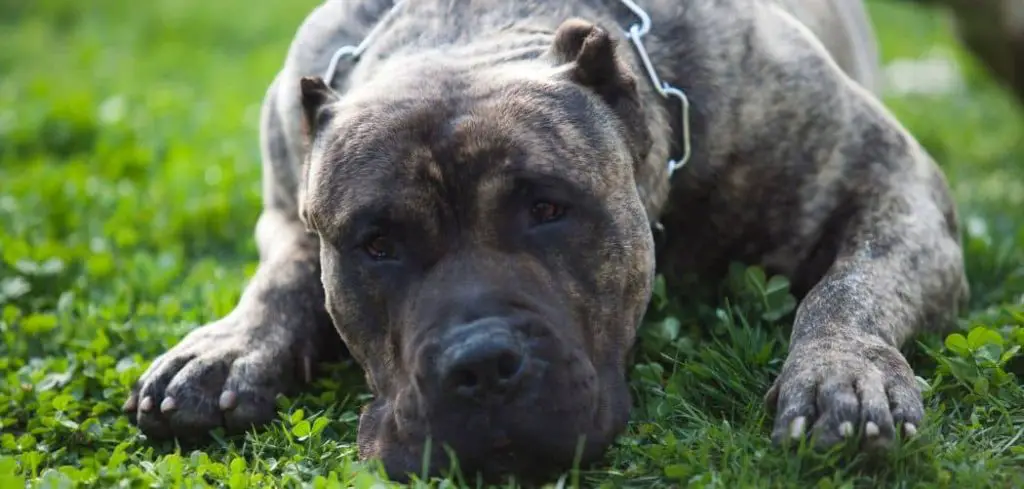Seeing your dog vomit and have diarrhea with blood is alarming and can signal a serious underlying health problem. These symptoms are never normal and should not be ignored.
We outline the common reasons why a dog being sick and diarrhea with blood may happen, what you can do at home, and when to seek veterinary help.
Table of Contents
Dog Being Sick and Diarrhea With Blood — Why It Happens
When a dog is both vomiting and passing bloody diarrhea, it usually means the gastrointestinal system is under severe stress. Possible causes include infections like parvovirus, sudden dietary changes, ingestion of toxins, internal parasites, pancreatitis, or conditions that cause severe inflammation of the intestines.
The presence of blood signals irritation, injury, or ulceration somewhere in the digestive tract, and the combination of vomiting with diarrhea means the illness is affecting the body systemically.
Timely veterinary evaluation is critical because dehydration, blood loss, and shock can develop quickly.

Dog Being Sick and Diarrhea With Blood: Common Causes
Parvovirus
Parvovirus is a highly contagious viral disease, most commonly seen in puppies and unvaccinated dogs.
The virus attacks rapidly dividing cells in the intestinal lining, causing severe vomiting and foul-smelling bloody diarrhea.
Dogs with parvovirus quickly become dehydrated, weak, and lethargic. Without urgent veterinary treatment, this condition is often fatal.
Vaccination is the best prevention, but once symptoms begin, immediate care is the only chance for survival.
Read more: Dog being sick and diarrhea (When to act fast)
Hemorrhagic Gastroenteritis (HGE)
Hemorrhagic gastroenteritis can appear suddenly in dogs that seemed perfectly healthy the day before.
The condition causes profuse vomiting and bright red bloody diarrhea that often looks like raspberry jam.
The exact cause isn’t always clear, but it can be linked to bacterial toxins, dietary indiscretions, or stress.
Because HGE leads to rapid fluid loss and potentially life-threatening dehydration, it requires prompt veterinary intervention with fluids and supportive care.
Toxin or Foreign Object Ingestion
If a dog swallows a toxic substance such as rat poison, spoiled food, or even certain plants, it can irritate or damage the stomach and intestines, leading to vomiting and bloody diarrhea.
Foreign objects like bones, toys, or fabric can also tear or block the digestive tract, creating both bleeding and sickness.
In these cases, the danger lies not only in the poisoning or obstruction itself but also in the risk of perforation and sepsis. Emergency veterinary care is always required.
Severe Intestinal Parasites
Roundworms, hookworms, whipworms, and other intestinal parasites can damage the lining of a dog’s intestines, leading to diarrhea, vomiting, and sometimes blood in the stool.
Heavy infestations are more common in puppies or neglected dogs and can cause anemia and weight loss.
While parasites may seem less dramatic than other causes, untreated infestations can be debilitating. Fortunately, proper deworming medication prescribed by a veterinarian is highly effective.
Pancreatitis
Pancreatitis is inflammation of the pancreas, often triggered by eating rich or fatty foods.
A dog with pancreatitis may vomit repeatedly, show abdominal pain, and develop diarrhea that sometimes contains blood.
The inflammation disrupts digestion and irritates the intestines, making the illness particularly painful and dangerous.
Pancreatitis can be mild or severe, but once bloody diarrhea appears alongside vomiting, hospitalization is often needed.
Gastrointestinal Ulcers
Ulcers in the stomach or intestines can occur due to certain medications (like NSAIDs or steroids), underlying illnesses, or even tumors.
These ulcers bleed into the digestive tract, producing bloody vomit (sometimes dark, like coffee grounds) and bloody stools.
Because ulcers may indicate a deeper systemic issue and pose a risk of perforation, they should always be considered a veterinary emergency.
What to Do
If your dog is vomiting and has bloody diarrhea, your first step should be to keep them calm and restrict access to food until you’ve spoken with a veterinarian.
Offering small amounts of water or ice cubes can help keep them hydrated, but too much water at once may trigger more vomiting.
Do not try home remedies like human medications, as many are toxic to dogs and can worsen bleeding. Monitor your dog closely for changes in energy, frequency of vomiting or diarrhea, and signs of abdominal pain.
If your dog is stable and your vet recommends supportive care at home, a bland diet (such as boiled chicken and rice) may be introduced gradually after symptoms subside.
However, most cases involving both vomiting and bloody diarrhea will require professional treatment with fluids, medications, and monitoring.
When to Call or Visit Your Vet
Contact your veterinarian immediately if your dog:
Is a puppy, senior, or has other health conditions.
Is vomiting continuously and cannot keep water down.
Produces large amounts of bloody diarrhea.
Appears weak, lethargic, or collapses.
Shows signs of abdominal pain, bloating, or shock (pale gums, rapid heartbeat, cold extremities).
These symptoms can deteriorate quickly, and waiting at home can make recovery far more difficult. Even if your dog seems to improve, underlying causes like parvovirus, HGE, or poisoning must be ruled out by a vet to ensure they don’t worsen suddenly.
Read more: Dog Being Sick and Pooping Blood (Why this can signal an emergency)
Key Takeaway
A dog being sick and having diarrhea with blood is always a serious warning sign. The combination of vomiting and bloody stools points to significant distress in the gastrointestinal system, whether from infection, poisoning, inflammation, or other critical conditions.
The best thing you can do as an owner is to act quickly: keep your dog hydrated if possible, avoid unsafe home remedies, and seek veterinary care without delay.
With prompt treatment, many dogs recover fully, but time is often the deciding factor between recovery and severe complications.
